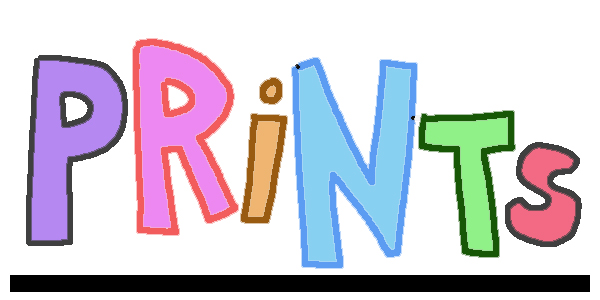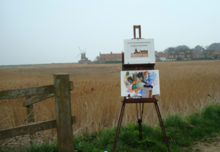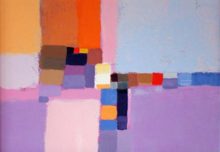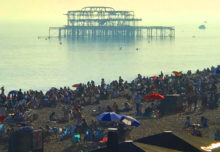“One day my prints will come” Snow White
…Another look at acrylographs and other printmaking…
My previous blog about – how technologic invention has affected the art world – ended with a focus on one of the latest examples, ‘acrylographs’.
People ask me to explain what an acrylograph is. What is the difference between Prints, monoprints, oleographs, lithographs, giclee, and acrylographs? So here goes.
Background to ‘printmaking’.
Prints.
Printmaking is an old craft used by artists since the invention of paper. The oldest techniques of woodcutting, engraving, and etching were followed by lithography where ink was rolled onto a flat stone that had previously had the image negative drawn with wax. Later silk-screen printing pushed the ink through a cloth screen that had the negative areas blocked with wax. Silk screen printing was useful because the screens could be used to print onto woven material for use in fashion and curtains. Later lithography [litho] using metal plates instead of stone could be used in machines enabling large quantities of prints to be made very quickly for commercial purposes.
All of these printing processes only printed one colour at a time. To get a multi-coloured print the process had to be repeated with new extra plates and different inks. Commercial litho printmakers used very small dots of the basic colours of red, blue, black, and yellow. These could be printed more or less on the same print run from different colour plates in sequence.
Some artists created their own colour palettes and sometimes printed many more colour runs once the previous colour dried. An edition of silk screen prints and hand created studio lithographs took many days to print at one colour a day.
Print runs had to be limited to allow for deterioration of the print making equipment. Woodcuts, etching and engraving became less sharp as the edition was printed. The quality of the print got worse as the print run grew.
In the UK another factor that influenced artistic printmaking was the introduction of purchase tax where limited small runs of a print were classified as artwork and tax free, whilst larger runs were not. Sellers had to pay a substantial part of the sale price to the exchequer if they sold open editions, but nothing if the prints were limited number ‘artworks’. The magic number was 75. So artists kept their editions to under 75 with each one signed and numbered to avoid setting higher prices or taking smaller cuts of the sale price. Eventually VAT replaced purchase tax and the tax implication vanished but the perceived value of ‘limited editions’ persisted.
Monoprint
…is an old term that indicates that a print is a one-off. It is unique in some way and not part of an edition of prints that are all the same, limited or not, numbered or not. A monoprint is the only one like it. it stops being a monoprint if there are more than one.
Oleograph
…refers to over-painting some of a lithographic edition to simulate oil paintings. The method was usually used to add interest to coloured lithograph reproduction prints on paper. Adding varnish and texture also protected the paper and the print could be displayed without glass.
Lithograph
…reproductions that are usually commercially published in large editions, on a fast printing machine. Some of the edition might be used to make oleographs. The technique goes back into the last century. It did mean that oleographs had some hands-on factor, but the whole operation was usually a commercial process without any involvement by the original artist.
Giclee.
…Then along came inkjet printing where all the colours were printed at once. Artists called the process giclee. Giclee sounded better than inkjet. The word came from the French for squirt because that was how the ink was applied to the print surface. Giclees can be printed onto paper or canvas.
Acrylographs
…are the result of much more recent technology.
The acrylographic process.
An artist first paints an original painting.
Then the artwork is scanned or photographed to make a digital file.
Then the artist can develop, and change the image using computer software.
The new image is giclee printed and stretched onto canvas.
Then the artist can over-paint the giclee print to make a new unique artwork.
The whole process should be undertaken by the original artist.
Another benefit is that at any point in the process a new image file can be captured and saved, to make the proof for a new signed and numbered edition.
There may be other use of this new term for some artwork. But for me they are ‘archival giclee prints with acrylic over painting’.
Conclusion.
Artists have been making prints using a variety of methods for a long time.
Acrylographs are the latest addition to the long list of artist’s artwork techniques.
Acrylographs, like originals, have unique texture and highlights.
They are artworks in a new space somewhere between prints and originals.
***************************************************
See also my previous blogs about acrylographs and giclee printing.
https://www.artpublish.com/giclee-the-best-thing-since-sliced-bread/ 3MAY2016
https://www.artpublish.com/oleographs-monoprints-and-acrylographs/ 21JUN2016
https://www.artpublish.com/more-about-acrylographs/ 8OCT 2017
https://www.artpublish.com/original-prints-reproductions/23DEC2017
https://www.artpublish.com/giclee-still-best-thing-since-sliced-bread/ 22MAY 2018
***************************************************





